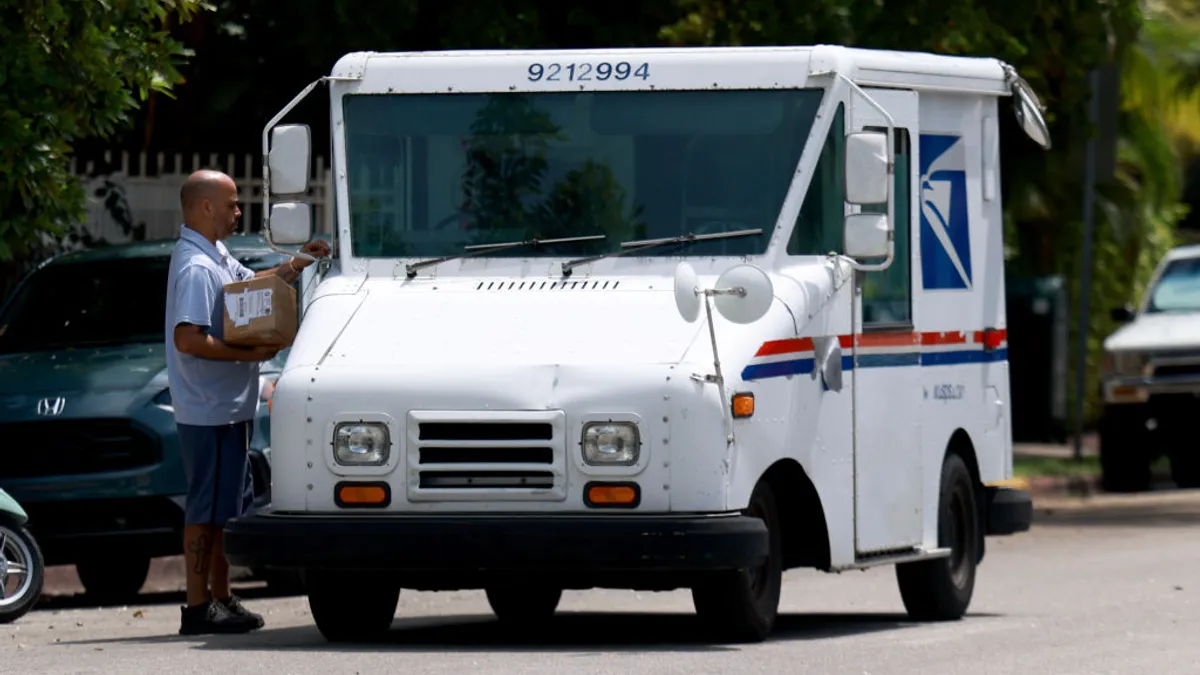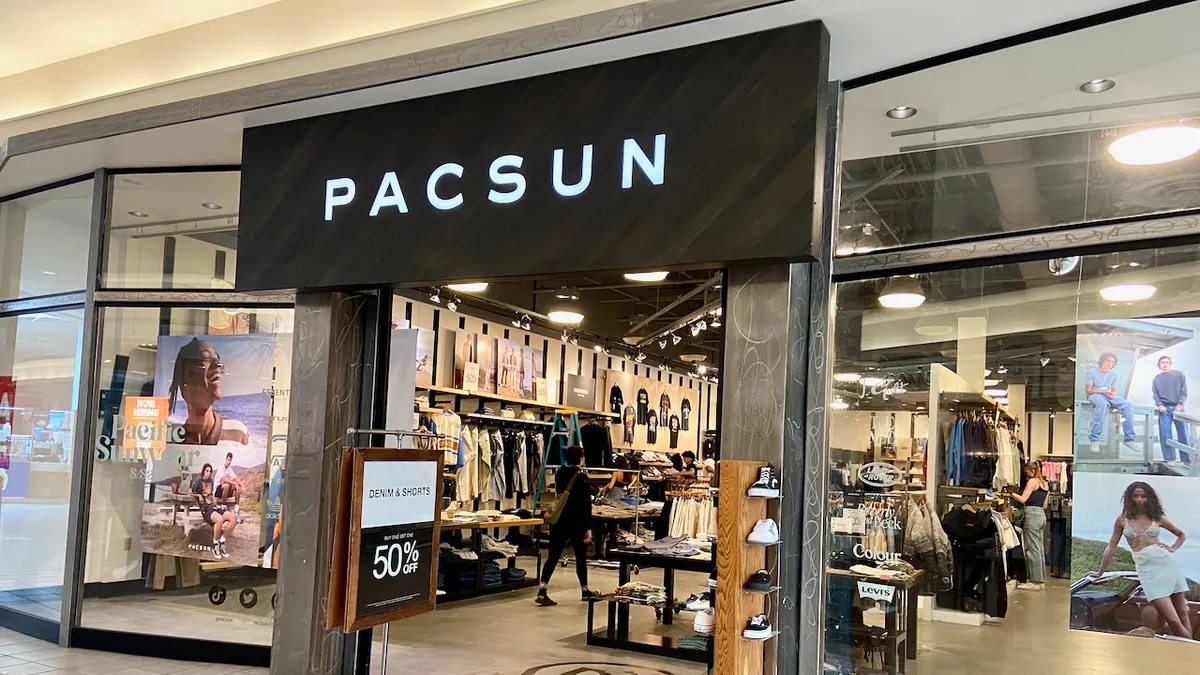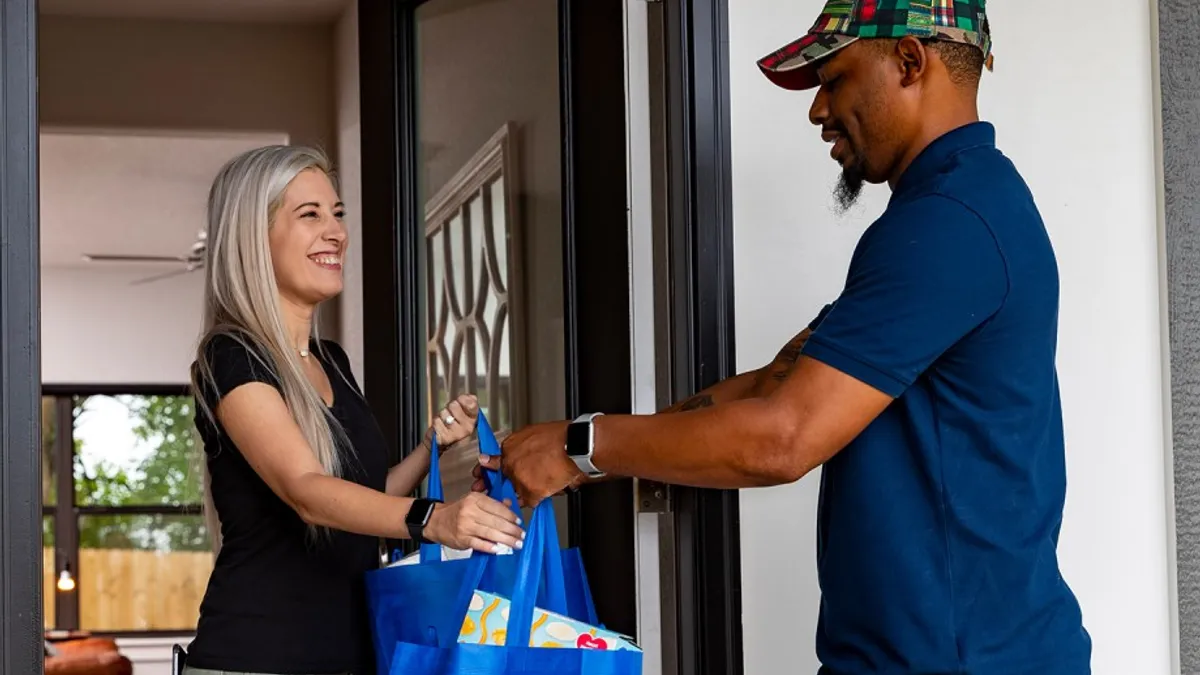Retailers’ desire to compete with Amazon Prime’s free two-day delivery sometimes means shipping in multiple packages. The problem: The process kills efficiency and eats up profits if items are out of stock or stored at different sites.
"Free delivery is a big drain on margin if you don’t get it right," Nick McLean, CEO of OrderDynamics, told Supply Chain Dive.
Retailers looking to improve margins could begin by looking at one metric — shipment to orders. This key performance indicator is used to compare the number of packages sent per individual order. A 1:1 ratio is the goal, but getting there involves planning, plus tradeoffs, said McLean.
Stores don’t seem to want to talk about that KPI. Many didn't respond to Supply Chain Dive inquiries, and one retailer specifically said they couldn't share this competitive information.
McLean said many retailers aren't sophisticated enough in their sales process to have thought the metric through. In the rush to offer and figure out e-commerce and omnichannel sales, most retailers don’t have a good understanding of how much stock is in particular stores compared to amounts sold online and through buy online pick up in store (BOPIS). Staffing, packaging and fulfillment costs add to the granularity that stores may not be tracking.
"From my research, I haven’t found [shipment to order] to be an easy number to find. Retailers aren't talking loudly about it," Charles Dimov, vice president of marketing at OrderDynamics told Supply Chain Dive.
Maximizing the shipment to order KPI
A number of factors determine how a company can maximize its shipment to order ratios, including order routing business rules, an order consolidation strategy, and fulfillment strategy which incorporates out of stock ratios.
To offer free shipping, some retailers mandate a minimum order purchase. This drives up the number of items per order, but also increases the chances that one or more items will be out of stock. "If you don’t have tremendously efficient networks, and you have to do split shipments, that’s problematic, because costs are going up," Dimov said.
The last mile is expensive, but when fulfilling from stores, doing store-to-store transfers can be less expensive than multiple shipments, said Dimov. It depends on the retailer, their capacity, and the frequency of transferring merchandise between stores.
"Free delivery is a big drain on margin if you don’t get it right."

Nick McLean
CEO, OrderDynamics
For regular sales seasons, adding an extra half- or full-day to consolidate the shipment may be worthwhile, assuming the retailer frequently ships between stores. If between-store transfers are every two to three days, that is a bigger concern. "I do believe the onus rests on retailers to understand their own internal capabilities and leverage the technology available," said Dimov.
Sending items in one shipment may not be possible if the business represents a number of brands and doesn't carry all items offered in-house, said McLean. Drop shipping items from the manufacturer will affect the shipment to order ratio.
Choosing multiple distribution centers versus one
Improving shipment to order ratios is easier for retailers relying on one distribution center, versus vendors with omnichannel orders fulfilled in stores and/or multiple distribution centers.
OrderDynamics is among the startups seeking to manage orders for retailers, to improve efficiency. It’s a competitive space: with companies like Flexe and ShipBob in the fold, targeting orders as a means to improve logistics efficiency. Each company, however, does this a little differently.
The more warehouses a retailer uses, the higher the inventory carrying cost. With multiple warehouses, "you gain faster and cheaper shipping, along with higher sales rates and lower cart abandonment rates," said Karl Siebrecht, CEO and co-founder of Flexe, which offers an Uber-like warehousing and fulfillment service. With more distributed inventory, he said, there’s also a lower cost per unit on the final shipping leg, because orders can be sent from closer distribution centers.
That’s offset, though, by higher inventory carrying costs, Siebrecht said. Companies can balance their stock distribution based on the nature of the inventory. Companies may put all their SKUs in two large distribution centers in different parts of the country, augmented with satellite facilities holding a subset of SKUs.
As part of their process, warehouse and fulfillment service ShipBob recommends where merchants put their inventory, said Divey Gulati, co-founder of ShipBob. They look at the customer location concentration and as well as items sold.
"Maybe there’s no demand in California for ice scrapers. That’s mostly in Chicago and New York, where you’ll want to offer faster delivery," Divey told Supply Chain Dive. That way, they minimize the number of shipments, placing items closer to where the customer is located.
Fulfill from store increases
Some retailers are opting to forgo distribution centers partly or completely when it comes fulfillment, and this can improve the shipment to order ratio.
Last holiday season, Target fulfilled 70% of its orders from the store, mostly within 24 hours, rather than from distribution centers. A $7 billion Target infrastructure investment is paying for remodeling at some retail locations’ backrooms to enable more efficient in-store fulfillment and shipping. More than 75% of the U.S. population lives within 10 miles of a Target store, decreasing those last mile costs. Also contributing to the shipment to order ratio: Target’s new inventory software lowered out of stock numbers by 40%, so more items can be shipped in one package.
Target is not alone. A 2018 study by Zebra Technologies showed that 91% of merchants agree that more retailers will turn stores into fulfillment centers, and 76% of retailers are already doing so. They’re decreasing selling floor space to accommodate the strategy.
"If you don’t have tremendously efficient networks, and you have to do split shipments, that’s problematic, because costs are going up."

Charles Dimov
Vice President of Marketing, OrderDynamics
Some OrderDynamics customers are completely closing their warehouse operations, saving millions of dollars in real estate by solely fulfilling from the store, McLean said.
They may start with a certain percentage fulfilled in the store and then expand from there. They have to consider which stores to use as hubs, as well as implications for how much inventory to set aside for the sales floor, compared to fulfillment space. Store location is another consideration. If the store is on the third floor of a mall, for example, regular shipping from there may not be practical. A large store with ample land is best equipped to handle the task.
Offering BOPIS is another strategy to improve the shipment to order ratio. It saves on shipping costs and increases in-store sales. Companies who offer this service should be promoting it more, said Dimov. He said that last year, around 48% of retailers who offered BOPIS didn't tell customers about it until the last stage of order placement online.
“You shouldn't keep it a secret,” said Dimov. "Tell customers about it on the first page — free shipping or in-store pick-up." Retailers will save money by not packaging items at their own cost, in most cases. "If you want to get your ship to order ratio down, this is a great way to do it."





















